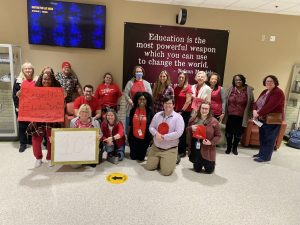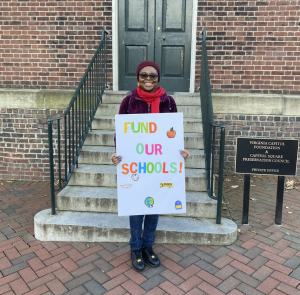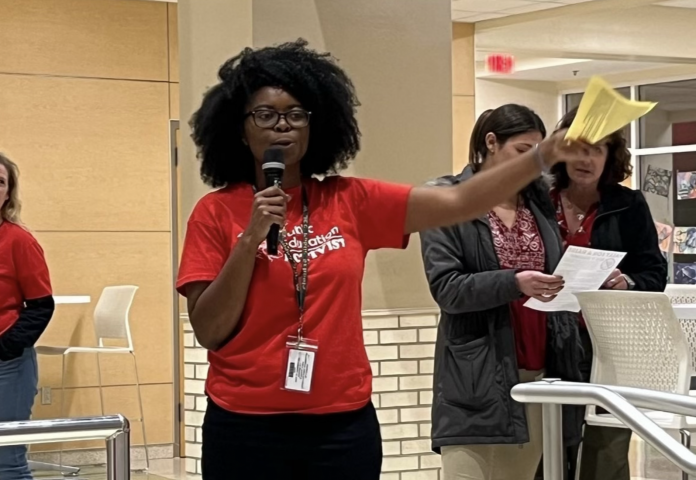Alynn Parham M.A. Ed ’18 found her future at the podium of her eighth grade classroom with the help of her social studies teacher, Mr. Yunker.
“He noticed I had a love for history and one day, I think as a joke, he was like ‘Parham, why don’t you take the podium and why don’t you teach?’,” Parham said. “I thought, ‘You know what? I like this.’”
A fifth-generation educator and product of public school education, Parham teaches social studies at Jamestown High School. Her current courses include World History II, World Geography and African American History.
“I’ve had teaching in my blood since… forever,” Parham said. “On top of that, education is a very important aspect in our family. Both of my grandparents went off to college. Both my parents, they’re professors, they have their Ph.D.s. Even my great grandparents went off to college.”
Parham noted how her grandparents’ dynamic with each of their students inspired her to see the potential that the student-teacher relationship has to positively shape students’ lives.
“I’ve been very blessed to have education as an important aspect in our family household on top of teaching,” Parham said. “Even to this day, their students still say, ‘If it wasn’t for Mr. Cain or Ms. Cain, I wouldn’t be where I was today.’ So seeing that growing up, made me want to be like them.”
At age 27, Parham has already made her mark not only at Jamestown High School, but on public education at a national level. She is the president of the local Williamsburg/James City County Education Association, the president of District P of the Virginia Education Association, and serves on the VEA Board of Directors for District P, which spans from Henrico to Hampton and includes 21 different locals.

Parham’s passion for educator unionization originally stemmed from her grandparents and her time spent as an undergraduate student at Virginia State University.
“Between the school of ed at VSU and my grandparents, they emphasize the extreme importance of joining the education association,” Parham said. “Whenever you walk into that classroom, you need to have that union card or badge on you for a variety of reasons — whether it’s resources, health, legal liability and so forth.”
The WJCCEA elected Parham as their local president during only her third year of teaching. She discussed how this role has helped her grow in her career and in her personal skills.
“Education union president has helped me become a better teacher because our state union provides a lot of professional development,” Parham said. “They have their own teaching and learning section within the state union so you can get PD for your job. It’s also helped me become a better leader, not just for the union but for myself. Like advocating for what I would need in my classroom for my students. And that is something that I will forever acknowledge and recognize that, if I had not been the union president, I don’t think that I would have been as strong a leader for myself.”
Throughout her incumbency as both the local and district president, Parham has traveled to local, regional, state and national conferences to meet and collaborate with other educators. March 10-12, Parham was one of about a dozen educators from the state to attend a leadership summit for the National Education Association in San Francisco, CA.
“I think sometimes you don’t realize there are other people just like you on the West Coast or in Hawaii or in Alaska,” Parham said. “The networking is surreal, and I was fortunate to end up connecting with a teacher in Pennsylvania and a teacher in Florida and also be in a group chat with other local union presidents from across the country.”
Nov. 15, 2022, the WJCCEA held their Rally for Raise event, officially kicking off a five-month push for a 10% raise for all WJCC school employees.
“We worked with our executive team, worked with our organizing team and reached out to teachers, members, parents, community supporters, League of Women Voters, the NAACP, the Village, United Campus Workers — who we’ve been chatting with — and they came out to give so many amazing testimonies. And then in December we went to the Board of Supervisors,” Parham said.
In March, the school board announced they would put the 10% raise in the budget.
“After this five-month long campaign, we’re now seeing the benefits of this rally,” Parham said.
She expanded on this topic, noting that locally, educator salary is one of the most important issues for public school teachers. Parham voiced that the biggest concerns for public school teachers state-wide include student discipline and funding from the state government. Student discipline has become especially pertinent in the state after a six-year-old Richneck Elementary student shot his first grade teacher in Newport News in January, making national headlines.
“I feel like our staff has become more vocal in addressing discipline issues and our school division has become very receptive to hearing those issues,” Parham said about changes in the local school systems following the incident.
“I do feel like a veil has been lifted, especially for those who are not aware as to what goes on in an everyday classroom, especially if you are in a school where there are disciplinary issues,” Parham said. “I do want to thank Newport News, their union, they’ve been working very hard dealing with ongoing staff concerns and staff issues, I know they did a town hall with their mayor, Mayor Jones. And I’ve talked to the president and I’ve given him my condolences and unity.”
In addition to educator salary and school safety, Parham also spoke to the issue of how standardized testing impacts K-12 students. She described how giving state-required exams like the Virginia Standards of Learning assessment are one of her least favorite parts of the job, as they often lead to student test-taking anxiety.
“As a teacher, you know in your heart of hearts that the child can tell you what they learned, but because it was formatted [a certain] way in the test, the anxiety, the overthinking, the second guessing, it can be a lot,” Parham said.

Issues like low salary wages, classroom safety, insufficient funding, student discipline and the emotional weight of teaching have all contributed to the systemic problem of education staffing shortages. Starting in 2021, the Virginia Department of Education’s Positions and Exits Collection began collecting data on education employee vacancies for each school year to create an annual Staffing and Vacancy Report.
According to the state-wide Staffing and Vacancy Report for the 2022-2023 school year, 3.9% of teaching positions in Virginia are unfilled. This state-wide report also shows that 6.0% of non-instructional personnel positions are unfilled, 6.8% of aides and paraprofessionals positions are unfilled and 3.4% of administrative positions are unfilled. In the Williamsburg-James City County division, 5.8% of non-instructional personnel positions are unfilled and 1.2% of teaching positions are unfilled.
“The central office is creating a focus on helping new teachers and retaining new teachers,” Parham said. “I do think that it is great that our division leaders are hearing and they’re noticing the concerns and trends, and are creating ways to not just attract new teachers, but also retain teachers and retain them past the three-year hump.”
Parham encouraged students considering going into teaching to recognize their “why” and to understand that it is not a profession in which you can clock in and clock out.
“Teaching is not just purely, ‘I work from 7:00 to 2:00 and I teach history and that’s it,’” Parham said. “Teaching is building relationships. Teaching is sometimes being that adult role model. Teaching is sometimes being a confidant. Teaching is sometimes being a parent. Teaching is sometimes checking emotional well-being. Teaching is making sure that they have food that day. Teaching is ‘Do they have money to go on the field trip?’ Teaching is working with the parents and coming together as a village to make sure that this child has what they need.”
Parham explained her “why.”
“I chose teaching because I want students to not only have a teacher who cares about them, but also for my students of color to know that they can see themselves in this profession,” Parham said.
She closed by noting her advice to future educators, that teaching is always worth the momentary struggles in the long run.
“Teaching is a very rewarding profession that you may not see at that moment, at that second, but when you do see the outcome it is overwhelming,” Parham said.

